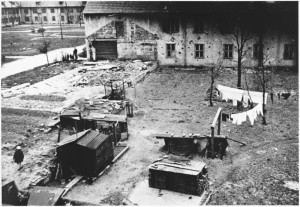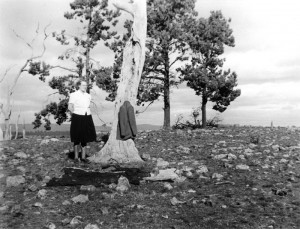Re-education in Memmingen

View of the yard at the Memmingen camp, c. 1947
After escaping from Latvia in 1944, the Apinis family lived in the Memmingen refugee camp in Germany. There was a weavers’ workshop set up in the basement, where Anna wove. Anna’s husband Ervins remembers:
All of the weaving began once we left – in the camp… when we had been thrown out of our lives, out of our jobs. I was no longer an engineer, I was nothing at all, and in the same way my wife was nothing, and our activities just started up on their own …. We also had to learn to do something practical…and all of the wives were so-called needlewomen and the men were taught mechanical work. I, for example, learnt welding, which was something completely foreign to me.
Arrival
After a number of years spent in the camp, the Apinis family arrived in Sydney Harbour on the General C. C. Ballou transport ship on the 23rd March, 1950:
We arrived here and entered Sydney. The first view was of the harbour and the big bridge. I was standing there at ten in the morning in beautiful sunny Australia – we were all standing on deck looking, full of joy about beautiful sunny Australia….at least there’s freedom here – we’ll be living in freedom.
Compulsory work contract
Post-war refugees who were allowed to come to Australia had to sign a two year compulsory work contract with the Australian government. Ervins Apinis, a road construction engineer by profession, was sent to work building railways in the state of New South Wales:
I lived in a tent for six months. Things were stolen from me countless times, you know, they cleaned out my suitcase … The main things they tried to steal were cigarettes….As I’d been registered as a construction technician, I was put on construction…but the work was purely labouring work….Maybe someone told me, I’ve now found adocument, there’s something written there. Now I understand fully what was written there. At that time I probably didn’t know anything. It was just simply not knowing, not knowing the language… I worked hard then, I worked nearly twenty nine years on the railways… I wasn’t just a labourer, but I had a labourer’s wage… In Latvia, all of my work was office work and I only went out by car to do some inspections. It was an engineer’s work.
Weaving already

Anna Apinis enjoying Australian nature c. 1950
While Ervins worked on the railways, Anna lived with her son Ēriks and other new arrivals at the Parkes camp:
My wife lived at Parkes, and I visited every second week. They gave us a free ticket…At Parkes they’d already decided to start weaving…the box had been brought out, the loom removed and put together and set up in her little room – when I went there, we slept on the floor. It was terribly hot at Parkes, with snakes. A real desert, you know, there was that real sultriness after the heat.
At the next camp the conditions were more tolerable:
It was a real paradise at Greta! The barracks were army style…one could plant flowers and gardens, there were flowerbeds already set up.






